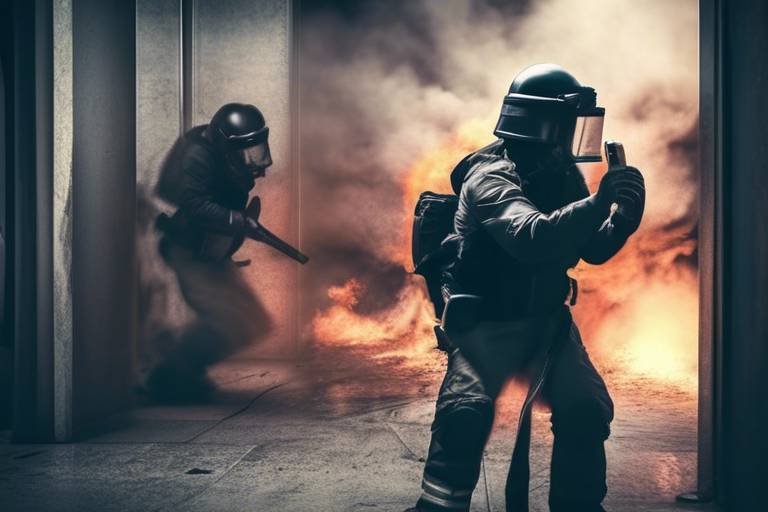Defusing Dangerous Situations - Personal Safety Tips
This article provides essential strategies for managing and defusing potentially dangerous situations. By understanding various techniques and approaches, individuals can enhance their personal safety and effectively navigate challenging encounters.
Recognizing the nature of a threat is critical for effective response. Whether you're walking through a crowded street or attending a social gathering, the ability to assess your surroundings can mean the difference between safety and danger. There are various types of threats one may encounter, from verbal confrontations to physical altercations. Understanding these threats requires a keen sense of observation and the ability to gauge risk levels accurately. The first step is to familiarize yourself with the environment and the people within it. Is there anything unusual? Are people behaving differently than expected? By asking these questions, you can make informed decisions about how to proceed.
Being aware of your surroundings can prevent dangerous encounters. Situational awareness is like having a sixth sense; it enables you to read the atmosphere and identify potential threats before they escalate. To improve your situational awareness, practice the following techniques:
- Always take note of exits and potential escape routes.
- Observe the body language of those around you.
- Stay off your phone and engage with your environment.
By honing these skills, you can recognize warning signs before a situation escalates.
Learn how to spot early indicators of aggression or danger. Recognizing these signs can empower you to act before a situation spirals out of control. Key behaviors to watch for include:
- Raised voices or aggressive gestures
- Clenching fists or tense muscles
- Intense staring or invading personal space
Understanding these signals can help you gauge the emotional state of individuals around you and take necessary precautions.
Understanding body language can provide insights into a person's intentions. For instance, if someone is crossing their arms and avoiding eye contact, they may be feeling defensive or aggressive. On the other hand, open body language, such as uncrossed arms and relaxed posture, often indicates a willingness to communicate. By paying attention to these cues, you can better navigate interactions and potentially defuse tension before it escalates.
The environment plays a crucial role in personal safety. Different settings can influence the likelihood of dangerous situations. For example, poorly lit areas or crowded places can heighten the risk of encountering aggressive behavior. Analyzing your environment involves asking questions like:
- Are there enough people around to help if needed?
- Is the area well-lit and visible?
- Are there any escape routes available?
By assessing these factors, you can make informed choices about where to go and how to act.
Your intuition can be a powerful tool in assessing danger. Sometimes, you might feel an inexplicable sense of discomfort in a situation. This gut feeling is often your subconscious picking up on subtle cues that your conscious mind may not immediately recognize. Trusting your instincts means acknowledging that feeling and taking it seriously. If something feels off, don’t hesitate to remove yourself from the situation. Your safety is paramount, and it’s better to be cautious than to regret ignoring your instincts.
Effective de-escalation can diffuse tension and prevent violence. When faced with an aggressive individual, employing certain strategies can help calm the situation. Here are some proven techniques:
Clear communication can help manage confrontations. Using a calm and steady voice can make a significant difference in how your message is received. Avoid raising your voice or using aggressive language; instead, aim for a tone that conveys understanding and empathy. Remember, the goal is to create a dialogue, not a debate.
Practicing active listening can foster a sense of respect and calm. When someone is upset, they often want to feel heard. Validate their feelings by paraphrasing what they say and showing that you understand their perspective. This can significantly reduce hostility and open the door for constructive conversation.
Knowing when to involve authorities is crucial for personal safety. If you find yourself in a situation that feels beyond your control, don’t hesitate to seek help. Recognize the signs that indicate professional intervention is necessary, such as:
- Escalating aggression from an individual
- Threats of physical harm
- Feeling unsafe despite attempts to de-escalate
When seeking assistance, remain calm and provide clear information about the situation to the authorities. Your safety and the safety of others is the top priority.
Q: What should I do if I feel threatened?
A: Trust your instincts and remove yourself from the situation if possible. If you feel it’s necessary, seek help from authorities.
Q: How can I improve my situational awareness?
A: Practice being mindful of your surroundings, engage with people around you, and avoid distractions like your phone.
Q: Are there specific body language cues I should look for?
A: Yes, look for signs of aggression such as clenched fists, raised voices, or tense body posture.
Q: What if my de-escalation attempts fail?
A: If your attempts to calm the situation don’t work, prioritize your safety and seek help from professionals.

Understanding the Threat
This article provides essential strategies for managing and defusing potentially dangerous situations. By understanding various techniques and approaches, individuals can enhance their personal safety and effectively navigate challenging encounters.
Recognizing the nature of a threat is critical for effective response. When we talk about threats, they can come in many forms, from verbal confrontations to physical altercations. Understanding the type of threat you are facing can significantly influence your response. For instance, a verbal threat might escalate if not addressed properly, while a physical threat may require immediate action. It's essential to assess the situation quickly and accurately to make informed decisions about how to proceed.
There are several categories of threats that one should be aware of:
- Verbal Threats: These can range from aggressive language to direct threats of violence. They often indicate that the individual is feeling threatened or insecure.
- Physical Threats: This includes any form of physical aggression, from pushing to more severe acts of violence. Recognizing body language and environmental cues can help in identifying when someone may become physically aggressive.
- Environmental Threats: Sometimes, the threat isn't from an individual but from the environment itself—like being in a poorly lit area or a location known for criminal activity.
To assess risk levels effectively, consider the following factors:
| Factor | Considerations |
|---|---|
| Location | Is it a safe area? Are there people around? |
| Behavior | Are individuals acting unusually? Is there aggression or agitation? |
| Time of Day | Are you in a safe place during the day or night? |
By understanding these factors, you can better navigate potentially dangerous situations. Remember, the key is to remain calm and observant. The more you practice assessing your surroundings and the people in them, the better equipped you'll be to handle threats when they arise. It's like being a detective in your own life, piecing together clues to understand the bigger picture of your environment.
Moreover, understanding the threat also involves recognizing your personal limits. Not every situation is one you can or should handle alone. If something feels off, it’s always better to err on the side of caution. Trust your instincts; they often guide you better than you might realize.
- What should I do if I feel threatened? Trust your instincts and remove yourself from the situation if possible. Seek help if necessary.
- How can I improve my situational awareness? Practice being observant in everyday situations. Take note of your surroundings and the behavior of those around you.
- When should I involve the authorities? If you feel that you or someone else is in immediate danger, do not hesitate to call for help.

Situational Awareness
Being aware of your surroundings is like having a superpower that can keep you safe in potentially dangerous situations. Imagine walking through a bustling market, the sounds of chatter and laughter surrounding you, but your senses are heightened. You notice the subtle shifts in the atmosphere, the way people move, and the little details that could indicate something isn't quite right. is all about being tuned in to what's happening around you and understanding how it might affect your safety.
To enhance your situational awareness, it's essential to develop a habit of scanning your environment constantly. This doesn't mean you should walk around paranoid, but rather, you should cultivate a mindset that prioritizes safety. Ask yourself questions like: Are there exits nearby? Is anyone acting unusually? How do I feel in this environment? By integrating these questions into your daily routine, you can create a mental checklist that sharpens your awareness.
One effective technique for improving situational awareness is to practice the “3-Second Rule.” This involves taking three seconds every so often to observe your surroundings. Look for:
- People: Are they behaving normally?
- Objects: Is there anything out of place?
- Movement: Is anyone moving towards you in a way that feels threatening?
Additionally, be mindful of environmental factors that could impact your safety. For instance, dimly lit areas or crowded spaces can increase the risk of danger. Consider how different environments can create various levels of comfort or discomfort. A well-lit street with lots of foot traffic generally feels safer than a deserted alleyway. Understanding these nuances can help you make informed decisions about where to go and when to leave.
It's also crucial to recognize that your instincts play a significant role in your situational awareness. If something feels off, it probably is. Trusting your gut feelings can lead you to make better choices in high-stress situations. Remember, your intuition is like an internal alarm system, alerting you to potential threats before your conscious mind even registers them.
In summary, improving your situational awareness is about more than just being observant; it’s about actively engaging with your environment. By developing a keen sense of awareness, you can spot warning signs early, assess risks effectively, and ultimately protect yourself from potential danger.
Q: What is situational awareness?
A: Situational awareness is the ability to perceive, understand, and anticipate your surroundings and the potential threats within them. It involves being aware of the environment, recognizing changes, and assessing risks effectively.
Q: How can I improve my situational awareness?
A: You can improve your situational awareness by practicing observation techniques, asking yourself critical questions about your environment, and trusting your instincts. Regularly scanning your surroundings and understanding environmental factors can also enhance your awareness.
Q: Why is situational awareness important for personal safety?
A: Situational awareness is crucial for personal safety because it helps you identify potential dangers before they escalate. By being aware of your surroundings and recognizing warning signs, you can make informed decisions that could prevent dangerous situations.

Identifying Warning Signs
In any potentially dangerous situation, being able to identify warning signs is crucial for ensuring your safety. Just like a smoke detector alerts you to danger before a fire spreads, recognizing these signs can give you the precious seconds needed to react appropriately. So, what should you be looking for? Well, it’s all about being observant and attuned to the behaviors of those around you.
First, let’s talk about aggressive body language. This can include clenched fists, tense posture, or a person invading your personal space. When someone stands too close, it might feel like they’re trying to establish dominance or provoke a confrontation. Additionally, watch for sudden movements or erratic gestures, as these can signal escalating emotions. For instance, if someone starts pacing or fidgeting excessively, it could indicate that they’re agitated.
Next, we have verbal cues. Listen carefully to the tone and content of what’s being said. A person who is shouting or using aggressive language is often signaling that they are angry or frustrated. In contrast, someone who speaks in a calm, measured tone is likely not a threat. Remember, the context matters. If someone is upset about a situation but is still communicating respectfully, they may just need an outlet for their feelings rather than posing a danger.
Another critical aspect to consider is the environment. Certain settings can heighten the risk of confrontation. For example, crowded places or dark alleys may serve as breeding grounds for aggressive behavior. Being aware of your surroundings allows you to gauge whether the location itself is contributing to the tension. If you’re in a bar and notice a group of individuals who are increasingly loud and rowdy, it might be time to consider your exit strategy.
Moreover, trust your gut feelings. If something feels off, it probably is. Intuition is a powerful tool that can guide you toward safety. Your instincts can often pick up on subtle cues that your conscious mind may overlook. For instance, if you notice someone watching you for an extended period or if you feel an inexplicable sense of dread, don’t dismiss those feelings. They may be your body’s way of alerting you to potential danger.
In summary, being able to identify warning signs involves a combination of observing body language, listening to verbal cues, assessing the environment, and trusting your instincts. The more aware you are, the better equipped you will be to react appropriately in a potentially dangerous situation. Remember, your safety is paramount, and being proactive can make all the difference.
- What are some common warning signs of aggression? Look for clenched fists, aggressive posturing, shouting, or erratic movements.
- How can I improve my situational awareness? Practice being present in your surroundings, and regularly assess the people and environment around you.
- What should I do if I feel threatened? Trust your instincts, remove yourself from the situation if possible, and seek help if necessary.

Body Language Cues
Understanding body language is like having a secret decoder ring for human emotions. It’s not just about words; it’s often what’s left unsaid that speaks volumes. When you're in a potentially dangerous situation, being able to read the subtle cues of another person's body language can be your first line of defense. For instance, if someone is clenching their fists, avoiding eye contact, or leaning forward aggressively, these are strong indicators of **hostility** or discomfort. It’s essential to recognize these signs early on, as they can help you assess whether a situation may escalate.
Let’s break down some common that you should keep an eye out for:
- Facial Expressions: A scowl or a furrowed brow can signal anger or discontent, while a forced smile may indicate insincerity.
- Posture: An open posture (arms uncrossed, relaxed stance) generally shows comfort, whereas a closed posture (crossed arms, hunched shoulders) can indicate defensiveness or aggression.
- Eye Contact: Intense or prolonged eye contact may suggest confrontation, while a lack of eye contact can indicate fear or discomfort.
- Proximity: If someone invades your personal space without invitation, it can be a sign of aggression or an attempt to intimidate.
Each of these cues can tell you a story about what someone is feeling, often before they even say a word. For example, if you’re in a conversation and notice the other person is leaning away from you, it could indicate they’re feeling threatened or uncomfortable. On the flip side, if they’re leaning in with open palms, they might be genuinely interested or trying to connect.
Moreover, the context matters immensely. A person may exhibit nervous body language in a crowded room due to anxiety rather than aggression. Therefore, it’s crucial to consider the environment and the individual’s past behavior. This holistic approach will help you make more informed judgments about the situation at hand.
In summary, being attuned to body language cues can significantly enhance your ability to navigate potentially dangerous situations. It’s like having an extra set of eyes that can see beyond the surface, allowing you to react proactively rather than reactively. Remember, your safety often hinges on your ability to read the room and the people in it.
- What should I do if I notice aggressive body language?
Trust your instincts. If you feel threatened, it’s best to remove yourself from the situation if possible. - Can body language be misinterpreted?
Absolutely! Context is key, so it’s important to consider the situation and individual differences. - How can I improve my ability to read body language?
Practice observing people in various settings, and consider taking courses on non-verbal communication.

Environmental Factors
When it comes to personal safety, the environment around you can significantly influence your risk of encountering danger. Imagine walking through a bustling city street compared to a quiet, dimly lit alleyway. The contrast is stark, and your level of alertness should change accordingly. encompass a range of elements, including location, lighting, and even the presence of other people. Each of these can either enhance your safety or heighten your vulnerability.
For instance, well-lit areas with a lot of foot traffic generally feel safer than isolated spots. The presence of other individuals can act as a deterrent to potential aggressors. Conversely, if you find yourself in a deserted area, especially at night, your senses should be on high alert. Awareness of your surroundings is crucial. Ask yourself questions like: Are there people around me? What are they doing? Is there an escape route if I need one?
Additionally, the layout of your environment can play a pivotal role in your safety. Consider the following factors:
- Accessibility: Are there exits nearby? Can you easily leave the situation if needed?
- Visibility: Is the area well-lit? Can you see potential threats before they see you?
- Familiarity: Are you familiar with the area? Knowing the layout can help you navigate safely.
Moreover, environmental factors can also include the presence of security features such as cameras, security personnel, or emergency call boxes. These elements not only provide a sense of safety but can also deter potential threats. If you notice such features in your surroundings, it can help you feel more secure and less anxious.
In summary, understanding your environment is a key component of personal safety. By being aware of the factors at play—like lighting, layout, and the presence of others—you can better assess your risk and take appropriate action. Remember, your safety often lies in your ability to read the signals your environment is sending you.
Q: How can I improve my situational awareness?
A: Practice being mindful of your surroundings. Look for exits, observe people's behavior, and trust your instincts. Regularly engaging in this practice can help you become more attuned to potential threats.
Q: What should I do if I feel unsafe in a public place?
A: Trust your gut feelings. If you feel uncomfortable, seek a more populated area, approach security personnel, or call for help if necessary. Always prioritize your safety.
Q: Are there specific environments that are more dangerous?
A: Yes, environments that are poorly lit, isolated, or have limited visibility can be more dangerous. Always be cautious in such areas and remain aware of your surroundings.

Trusting Your Instincts
When it comes to personal safety, one of the most underrated tools at your disposal is your own intuition. Imagine walking down a quiet street at night, and suddenly, you feel a chill run down your spine. That feeling is your instincts kicking in, alerting you to potential danger. is not just about having a gut feeling; it's about honing your ability to recognize when something feels "off." This instinctual response is often a culmination of your past experiences, observations, and even subtle cues from your environment that your conscious mind might overlook.
Our instincts are like an internal alarm system. They can warn us about various threats, whether they be physical, emotional, or social. For instance, if you're in a crowded place and notice someone behaving suspiciously, that uneasy feeling might be your instincts telling you to be cautious. It's essential to cultivate a relationship with your instincts and learn to differentiate between irrational fears and genuine concerns. Ask yourself: Is this feeling based on past experiences or just a fleeting thought? Understanding this can help you act appropriately in potentially dangerous situations.
Moreover, it's important to remember that instincts can vary from person to person. What feels threatening to one individual may not feel the same to another. This variance is influenced by factors such as personal history, cultural background, and even personality traits. Therefore, it's crucial to respect your feelings and those of others. If your gut tells you to leave a situation, do so without hesitation. Your safety is paramount, and acting on your instincts can often mean the difference between a close call and a dangerous encounter.
Additionally, trusting your instincts also involves being aware of your emotional state. Sometimes, anxiety or stress can cloud your judgment, making it harder to identify genuine threats. Practicing mindfulness techniques, such as deep breathing or grounding exercises, can help clear your mind and allow your instincts to guide you more effectively. This way, you can differentiate between a simple case of nerves and a legitimate warning sign.
In summary, your instincts are a powerful ally in ensuring your personal safety. By paying attention to those subtle feelings and learning to trust them, you can navigate potentially dangerous situations with greater confidence. Remember, your gut feelings are not just random thoughts; they are a culmination of your life experiences and awareness of your surroundings. So, the next time something feels off, don't dismiss it—listen to your instincts and take action to protect yourself.

De-escalation Techniques
When it comes to defusing potentially dangerous situations, mastering can be a game changer. Imagine walking into a room where tensions are running high—people are shouting, and the atmosphere is thick with hostility. Instead of jumping into the fray, you can choose to calm the storm. This is where de-escalation comes into play. The goal here is to reduce the intensity of a conflict, allowing for a peaceful resolution rather than a violent outburst. But how do you do that? Let’s dive into some effective strategies.
First and foremost, communication skills are essential. The way you express yourself can either fan the flames or extinguish them. Using a calm and steady voice can help set the tone for the interaction. Imagine trying to calm a wild animal; if you shout or make sudden movements, you could provoke it further. Instead, speak softly and clearly, using words that convey empathy and understanding. For instance, phrases like "I understand you're upset" can validate the other person's feelings, making them feel heard and less defensive.
In addition to verbal communication, non-verbal cues play a significant role in de-escalation. Your body language can either invite trust or breed suspicion. Maintain an open posture—avoid crossing your arms or pointing fingers, as these actions can be perceived as aggressive. Instead, try to keep your hands visible and relaxed. Eye contact is also crucial; it shows that you are engaged and genuinely interested in resolving the issue. However, remember to avoid staring, as that can come off as confrontational.
Another important aspect is active listening. This means not just hearing what the other person is saying but truly understanding their perspective. When you practice active listening, you can reflect back what the other person has said, which demonstrates that you value their input. For example, you might say, "It sounds like you're feeling frustrated because..." This not only helps to clarify their feelings but also fosters a sense of respect. When people feel respected, they are more likely to lower their defenses.
But let's not forget about the environment. Sometimes, the setting can escalate tensions. If you find yourself in a crowded or noisy place, consider moving to a quieter location where both parties can speak without distractions. This simple change can make a world of difference. Think of it like trying to have a conversation at a rock concert—it's nearly impossible to hear each other over the noise!
Lastly, knowing when to step back is crucial. If you feel that the situation is becoming too heated or unsafe, it's perfectly okay to disengage. You can say something like, "I think we both need some time to cool off. Let’s revisit this later." This approach not only shows maturity but also prioritizes safety over the need to resolve the issue immediately.
In summary, mastering de-escalation techniques involves a combination of effective communication, active listening, awareness of body language, and understanding the environment. By implementing these strategies, you can significantly reduce the chances of a situation escalating into something dangerous. Remember, the goal is not to 'win' the argument but to find a peaceful resolution that respects everyone involved.
Q: What are de-escalation techniques?
A: De-escalation techniques are strategies used to reduce tension and prevent conflict from escalating into violence. They involve effective communication, active listening, and awareness of body language.
Q: When should I use de-escalation techniques?
A: De-escalation techniques can be used in various situations, such as conflicts at home, in the workplace, or during public disputes. Whenever you sense that tensions are rising, it's a good time to apply these techniques.
Q: Can de-escalation techniques work in all situations?
A: While de-escalation techniques can be effective in many scenarios, they may not work in every situation, especially if the other party is unwilling to engage peacefully. It's essential to prioritize your safety and know when to seek help.

Communication Skills
When it comes to defusing potentially dangerous situations, effective communication skills can be your best ally. Imagine you're in a tense scenario, and the air is thick with hostility. Your ability to communicate clearly and calmly can make all the difference. But what does that entail? It’s not just about the words you choose; it’s also about how you deliver them. Your tone, body language, and even your facial expressions play a significant role in how your message is received.
First and foremost, maintaining a calm demeanor is crucial. When faced with aggression, your instinct might be to react defensively. However, taking a deep breath and speaking in a steady, soft voice can help de-escalate the situation. This approach signals to the other person that you are not a threat and that you are there to listen rather than confront. Think of it as throwing a lifeline into turbulent waters; your calmness can help stabilize the emotional environment.
Moreover, non-verbal communication is just as important as verbal communication. Your body language can convey messages that words sometimes cannot. For instance, maintaining an open posture—arms uncrossed, hands visible—can create a sense of safety. Avoiding aggressive stances, such as pointing or clenching your fists, is essential. Instead, use gestures that indicate you’re engaged and approachable. Nod your head occasionally to show you’re listening, and maintain eye contact to build trust.
In addition to these techniques, it’s vital to practice active listening. This means not just hearing the words being said, but truly understanding the feelings behind them. When someone is upset, they often just want to be heard. By paraphrasing what they say, you validate their feelings and demonstrate that you are genuinely interested in resolving the conflict. For example, if someone says, “I feel ignored,” you might respond with, “I hear you saying that you feel overlooked, and I want to understand more about that.” This not only shows empathy but can also diffuse anger.
Lastly, it’s essential to know when to set boundaries. While communication is key, it’s equally important to protect your own safety. If the situation escalates despite your best efforts, don’t hesitate to step back and remove yourself from the environment. Sometimes, the most powerful thing you can say is, “I think it’s best if we take a break and revisit this later.” This statement can help prevent further escalation and give both parties time to cool down.
In summary, mastering communication skills in high-stress situations is not just about what you say but how you say it. By combining a calm demeanor, effective non-verbal cues, active listening, and setting boundaries, you can navigate through conflicts more effectively. Remember, in the dance of communication, it’s not just about leading; it’s about knowing when to follow and when to step back.
- What should I do if someone is aggressive towards me?
Stay calm, use non-threatening body language, and try to communicate openly. - How can I improve my active listening skills?
Practice paraphrasing and summarizing what others say to ensure understanding. - When should I seek help from authorities?
If you feel threatened or if the situation escalates beyond your control, it’s best to contact law enforcement.

Active Listening
Active listening is more than just hearing the words that someone is saying; it's about truly engaging with the speaker and understanding their message. Imagine you're in a heated discussion—your heart is racing, and your mind is buzzing with thoughts. In moments like this, it's easy to zone out or start formulating your response before the other person has finished speaking. However, practicing active listening can transform this scenario into a constructive dialogue.
So, what exactly does active listening involve? First and foremost, it requires full attention. This means putting away distractions, making eye contact, and showing that you are genuinely interested in what the other person is saying. Think of it like tuning into your favorite radio station; if you're not fully focused, you'll miss out on the details of the song. By giving your undivided attention, you send a clear message that their feelings and thoughts matter.
Next, you can enhance your active listening skills by using verbal and non-verbal feedback. Nodding your head, using affirmations like "I see" or "I understand," and even repeating back key points can show the speaker that you are engaged. This feedback loop not only validates their feelings but also encourages them to share more. For instance, if someone expresses frustration about a situation, responding with, "It sounds like you're really upset about that," can help them feel heard and understood.
Moreover, it’s crucial to avoid interruptions. While it may be tempting to jump in with your own thoughts, doing so can shut down the conversation and create defensiveness. Imagine trying to solve a puzzle while someone keeps throwing pieces at you without letting you see the whole picture. By allowing the speaker to finish their thoughts, you can gain a clearer understanding of their perspective and respond more thoughtfully.
Another key aspect of active listening is asking open-ended questions. Instead of simple yes or no questions, try to encourage deeper conversation. Questions like "How did that make you feel?" or "What do you think could be done differently?" invite the speaker to elaborate and share their feelings more fully. This not only helps clarify the situation but also builds trust and rapport between both parties.
Lastly, practicing empathy is vital in active listening. Try to put yourself in the other person's shoes and understand their feelings. This doesn’t mean you have to agree with them, but acknowledging their emotions can go a long way in diffusing tension. Think of it like being a mirror; when someone sees their feelings reflected back at them, it can create a sense of validation and connection.
In summary, active listening is an essential skill that can significantly improve communication and conflict resolution. By giving your full attention, providing feedback, avoiding interruptions, asking open-ended questions, and practicing empathy, you can create a more positive and constructive dialogue. Remember, the goal is not just to hear but to understand and connect. In a world where misunderstandings can escalate quickly, mastering active listening can be your secret weapon in defusing potentially dangerous situations.
- What is the difference between hearing and listening? Hearing is simply the act of perceiving sound, while listening requires focus and engagement with the speaker's message.
- Can active listening help in personal relationships? Absolutely! Active listening fosters better communication and understanding, which are crucial for healthy relationships.
- How can I improve my active listening skills? Practice being present, avoid distractions, provide feedback, and ask open-ended questions to enhance your active listening abilities.
- Is active listening useful in professional settings? Yes, it can lead to better teamwork, conflict resolution, and overall workplace harmony.

When to Seek Help
Knowing when to involve authorities can be a crucial aspect of ensuring your personal safety. It's not always easy to determine the right moment to seek help, especially when emotions run high and situations can escalate quickly. However, recognizing the signs that indicate a need for professional intervention can make all the difference in avoiding potential harm. So, how do you know when it's time to pick up that phone and call for help?
First and foremost, if you ever feel threatened or unsafe, trust your instincts. Your gut feeling is often your best ally in recognizing danger. If a situation makes you uncomfortable, it's better to err on the side of caution. You might be wondering, "What specific situations should I be looking out for?" Here are some key indicators:
- Escalating Aggression: If you notice that someone is becoming increasingly aggressive or hostile, it's time to consider seeking help. This could manifest through raised voices, threatening body language, or verbal abuse.
- Physical Threats: If someone is making direct threats to harm you or others, do not hesitate to contact authorities. Your safety is paramount, and threats should never be taken lightly.
- Unfamiliar or Suspicious Behavior: If you encounter someone acting in a way that seems suspicious or out of place, especially in a vulnerable setting, it’s wise to seek assistance. This could include someone loitering in a parking lot or behaving erratically.
Additionally, consider the environment around you. Are you in a crowded place where help is readily available, or are you in a secluded area where you might be at greater risk? Your surroundings can significantly influence your decision. For instance, if you're alone in a dimly lit area and feel uneasy, it's a clear sign that you should reach out for help.
Another important factor is the presence of bystanders. If others are around and appear to be ignoring the situation, it may be time to take action. Don’t assume that someone else will step in; you must advocate for your own safety. You can also ask someone nearby for assistance, as having another person with you can deter potential threats.
In some cases, it might not be an immediate threat but rather a situation that feels precarious or uncomfortable. If you're unsure how to handle the scenario, it can be beneficial to contact authorities for guidance. They can provide advice on how to proceed or, if necessary, send someone to assess the situation. Remember, it’s always better to be safe than sorry.
In conclusion, recognizing when to seek help is a vital skill that can protect you in dangerous situations. Trust your instincts, assess the environment, and don't hesitate to involve authorities when you feel it's necessary. Your safety is worth it, and there’s no shame in asking for help when you need it.
1. What should I do if I feel threatened in a public place?
If you feel threatened, trust your instincts and seek help immediately. Look for security personnel or call the authorities if necessary.
2. How can I assess if a situation requires police involvement?
If there are signs of escalating aggression, direct threats, or suspicious behavior, it’s important to consider involving the police for your safety.
3. Is it okay to call for help if I’m unsure about a situation?
Absolutely! It’s always better to be cautious. If something feels off, don’t hesitate to reach out for assistance.
4. How can I improve my situational awareness?
Stay alert to your surroundings, observe the behavior of those around you, and trust your instincts. Practice being aware of exits and safe spots in your environment.
Frequently Asked Questions
- What should I do if I feel threatened in a public place?
If you feel threatened in a public place, trust your instincts. Look for a safe exit and try to remove yourself from the situation as quickly as possible. If you can, seek help from nearby individuals or authorities. Remember, your safety is the top priority.
- How can I improve my situational awareness?
Improving your situational awareness involves being mindful of your surroundings. Practice scanning the area regularly, noting exits, and observing the behaviors of those around you. Engaging in activities like mindfulness or self-defense training can also enhance your awareness skills.
- What are some common body language cues to watch for?
Common body language cues that may indicate aggression include clenched fists, an aggressive stance, or invading personal space. Look for signs of discomfort, such as crossed arms or avoiding eye contact, as these may suggest someone is feeling threatened or defensive.
- How can I de-escalate a tense situation?
To de-escalate a tense situation, use clear and calm communication. Maintain a non-threatening posture and listen actively to the other person’s concerns. Validate their feelings, and try to find common ground to foster understanding and reduce hostility.
- When should I seek help from authorities?
You should seek help from authorities if you feel unsafe or if a situation escalates beyond your control. If you observe aggressive behavior that could lead to violence or if someone is threatening you or others, don't hesitate to call for professional assistance.



















